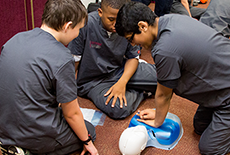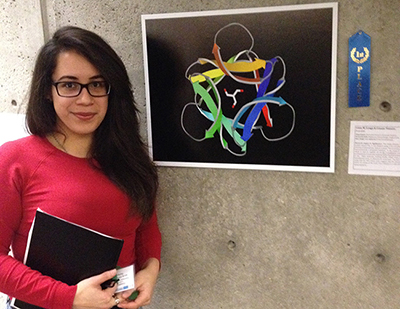Less than a year after finishing her undergraduate degree and winning a McKnight Fellowship, first-year biomedical doctoral student Connie Tenorio is winning again. This time, for art.
Tenorio took part in the annual ‘Art in STEM Research’ exhibit, where photographs taken by FSU students in the STEM (science, technology, engineering and math) fields who successfully capture the artistic beauty of scientific research in digital images, are displayed in the Dirac Science Library. The artistic scientist with the winning image is awarded a $50 prize.
A graduate student in the Blaber lab, Tenorio won for her "X-ray crystal structure of a designed ‘pre-biotic’ protein," which she worked on with fellow graduate student Liam Longo. Her background helped. Tenorio studied the history of art during her undergraduate career and has a strong appreciation for the art of science.
"Creativity is integral to a successful career in science," said Tenorio. "Finding the beauty in your own scientific research is one of the many joys in this line of work. The Art in STEM Research exhibit was an outreach event geared toward getting undergraduates interested in science, not by the usual technical description of research, but by using images of what each person finds beautiful about their science.
"The image Liam and I submitted is the crystal structure of one of the proteins we work on in our lab called PV2. It was obtained using X-ray crystallography, a technique used to visualize the structure of biopolymers, such as proteins. This particular protein adopts a beta-trefoil fold, which is characterized by its symmetric structure. In the center of this crystal structure is another symmetric molecule, Tris, which is used to regulate pH during crystallization conditions. Tris highlights and compliments the symmetry of PV2. A component of beauty has always been symmetry, which is all around us in nature. In fact one third of all proteins are symmetric.
"Importantly, PV2 is comprised predominately of molecular building blocks that were present on the early Earth, before the emergence of life. These molecular building blocks, called amino acids, can be generated by lightning, in hydrothermal vents, or delivered by meteorites. The fact that we were able to create a beta-trefoil using only the “old” amino acids, suggests that the chemical information on the early earth—even before the advent of life itself—was sufficient to create useful molecular tools that are still used by living organisms."


 Nearly 150 eighth- through 10th-graders from five counties across Florida earned their CPR certification Jan. 23 as participants in the Florida State University College of Medicine’s SSTRIDE program. SSTRIDE (Science Students Together Reaching Instructional Diversity and Excellence) was developed in 1994 by Outreach and Advising Director Thesla Berne-Anderson to increase primary care physician talent in rural and underserved areas in Florida through classroom and after-school teaching.
Nearly 150 eighth- through 10th-graders from five counties across Florida earned their CPR certification Jan. 23 as participants in the Florida State University College of Medicine’s SSTRIDE program. SSTRIDE (Science Students Together Reaching Instructional Diversity and Excellence) was developed in 1994 by Outreach and Advising Director Thesla Berne-Anderson to increase primary care physician talent in rural and underserved areas in Florida through classroom and after-school teaching.
 First-year students Kathryn Barbon and Alexia Loyless recently had dinner with a physician-intern who was 5,000 miles from home – and who made quite an impression on them.
First-year students Kathryn Barbon and Alexia Loyless recently had dinner with a physician-intern who was 5,000 miles from home – and who made quite an impression on them.